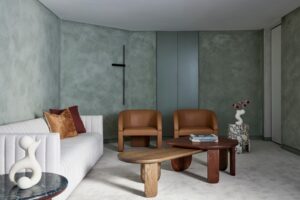How much design can you input into a tiny apartment? For William Ng of Studio Wills + Architects, this project showcases much.
The client is a graphic designer who requested plenty of storage spaces (including compartments to keep the oven and coffee maker away when not in use), and privacy as the living, dining and kitchen open to the external corridor when the entrance door is opened.
The existing apartment had one bedroom and a study. Before Ng came on board, it lacked substantial storage and wardrobe space, the services were exposed, or concealed within bulkheads or were boxed-up so maintenance was difficult, and the bathroom was basic and uninspiring.

Ng’s main aim was to achieve “a sense of space and spaciousness.” He consolidated all the storage spaces into a ‘core’, which manifests as a box. “Everything has its place, and is in place,” Ng quips.
“Circulating through and along the periphery of the ‘box’ is a continuous flow of spaces, looping through the foyer, anteroom, living, dining, kitchen, bedroom and bathroom [and then back to the foyer],” he describes. The daily rituals of living, dining and sleeping revolve around this box. Fluid movement through the apartment augments the sense of space.

The box comprises the existing kitchen core, bathroom and an ancillary area next to the foyer. Near the entrance are a shoe cabinet, general storage and a compartment for the distribution board (DB). In the kitchen area, Ng added a flip-up panel for access to services. Next to the bedroom, wardrobes flank the bathroom door.
Aside from storage, this box also functions as a formal threshold between the anteroom and bathroom on one side, and the bedroom and the bathroom on the other. “Hidden within the heart of the box is the bathroom, encountered as a surprise when one opens the door in the box and steps in,” says Ng.

Timber laminate emphasises the box’s presence within the light-filled space and introduces a sense of warmth into the home. To perpetuate the box’s monolithic form, Ng also lined the bathroom’s wall and floor with timber-like tiles.
“A latte-coloured countertop also helps to create the illusion of being inside a block of timber,” he highlights. To maximise the use of the compact bathroom, he carved out a display-cum-storage niche in the sanitary stack, as well as added a medicine cabinet-cum-vanity mirror that runs the length of the bathroom.

Another strategy to create the feeling of a more spacious home is by layering the spaces through the use of curtains rather than doors to divide the spaces. “They also help to diffuse lighting from external-facing openings within the apartment,” Ng explains.
Soft lighting helps to perpetuate the cosy atmosphere and thoughtfully placed furniture creates focal points through the spatial loop. Loose furniture and accessories allow the owner to move things around easily and wherever needed so there is no need to double up on pieces.

This flexibility is an additional objective Ng set out to achieve in order to create a sustainable design: limiting the fittings to the box and allowing the spaces around the box to be free, as well as the creation of a pared-down interior creates a neutral foil for different and interchangeable furniture layouts.
Project details
Interiors – Studio Wills + Architects
Photography – courtesy Studio Wills + Architects


We think you might like this apartment with a secret passageway.

















